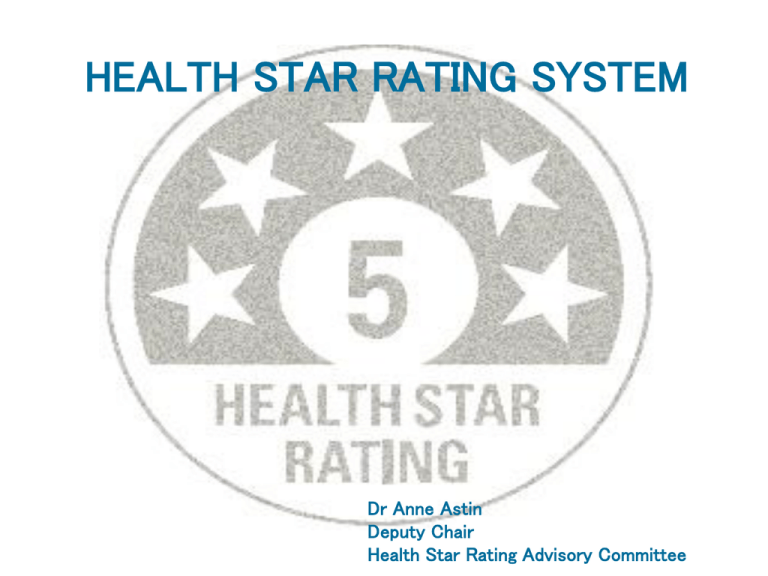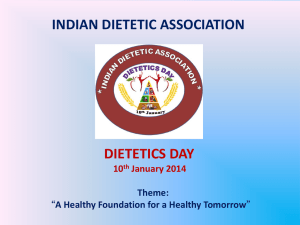Stakeholder-Workshop-Presentatio
advertisement

HEALTH STAR RATING SYSTEM Dr Anne Astin Deputy Chair Health Star Rating Advisory Committee Aim of the Health Star Rating System ‘To provide convenient, relevant and readily understood nutrition information and/or guidance on food packs to assist consumers to make informed food purchases and healthier eating choices.’ A scheme that can guide consumer choice towards healthier food options and aims to guide consumer choice by: • Enabling direct comparison between individual foods that, within the overall diet, may contribute to the risk factors of various diet related chronic diseases. • Being readily understandable and meaningful across socio-economic groups, culturally and linguistically diverse groups and low literacy/low numeracy groups. • Focus on processed, packaged food at retail level Development process Legislative Governance Forum on Food Regulation Food and Health Ministers Steering committee FRSC based with AHMAC representation Project committee State, Industry, Health and Consumer representations Technical Design Working Group (TDWG) Industry, Public Health, Food Regulation Implementation Working Group (IWG) Industry, Public Health, Food Regulation SA Health The Health Star Rating System • Front of Pack Label, displaying an interpretive score (health star rating score – HSRS) along with the optional display of defined nutrient icons within a standardised design. • Underpinned by the HSR Style Guide and Guide to Industry to the HSR Calculator, and with reference to the Food Standards Code and the Australian Guide to Health Eating. • Star rating derived using modified NPSC model • Baseline points (key nutrients – saturated fat, total sugars, sodium and energy) • Modifying points (positive nutrients – protein, fibre, fnvl) • Points attributed to nutrient levels (per 100g) • Convert points to Health Star Rating: score range ½-5 stars in ½ star increments 4 HSR Style Guide and HSR Label Development HSR Style Guide • Developed in consultation with industry, public health, consumer and Government representatives. • Targeted consultation with industry, public health and consumer stakeholders – Nov and Dec 2013. • Feedback – greater flexibility in the artwork to accommodate vertical display of stars and stacked nutrient icons where package/shape requires. • HSR Style Guide is available at www.ahmac.gov.au. 5 HSR Style Guide and HSR Label Development HSR Label Artwork • Consultation with industry regarding flexibility of design specifications in the HSR Style Guide. • Alternative artwork developed in consultation with food companies and retailers. • The FoPL Secretariat can provide design files of the artwork – frontofpack@health.gov.au or 1800 099 658. 6 Key Elements of Artwork Nutrient icons • • • • • The Health Star Rating OPTIONAL - energy display %DI or ‘per serve’ when product is a single consumption pack only Energy Sat Fat Sugars Sodium + option positive nutrient OPTIONAL – addition of ‘High’ or ‘Low’ determined by Health Claims Standard * Label elements endorsed by the Forum 12/6/13 Use of the label • HSR system label must be displayed on the front of the packaged food. • Must conform with Legibility Requirements (STD 1.2.9). • No defined colour guidelines. Intention to ensure maximum legibility using contrast of existing colour palette. • May be used in conjunction with other existing systems i.e. DIG, however, placement must be made to ensure that they are clearly separated. 8 Label Hierarchy Food companies are encouraged to use as many elements of the HSR System as possible consistent with the hierarchy. 1. Energy icon + health star rating + 3 prescribed nutrient icons + 1 optional nutrient icon (recommended) 2. Energy icon + health star rating + 3 prescribed nutrient icons (recommended) 3. Energy icon + health star rating 4. Health star rating or just energy icon. • It is the responsibility of food companies to determine which presentation format is most suitable for their products, based on available pack size and label space. • The energy icon in option 4 is best suited for small packages / labels, as well as some confectionery and beverages. Example designs 10 Using the HSR calculator Adopters & Supporters Workshops August/September 2014 HSR development process Stage (1) Profiler scores • Collect food nutrient data from industry, including fibre and FVNL content not available in NIPs • Validate nutrient content data using FSANZ food modelling tools • Remove duplicate foods • Remove exempted foods • With assistance from FSANZ verify that (1) the food database adequately covers the scope of foods and nutrient content in the Australian/New Zealand market, and that (2) all AGHE categories are represented Food database • Extend and/or in-fill NPSC profiler ‘A’ & ‘C’ nutrient tables, to cover the full scope of nutrient content in the market • Confirm the profiler categories for the extended NPSC (food, beverages, fats/cheese) • Allocate all foods to their respective category • Profile all foods by category using the extended tables, following the profiling methods set out in ANZFSC 1.2.7 • Verify that the HSR calculator and FSANZ STATA NPSC models agree using the extended tables, for all foods in the database • Collect additional food data, calculate the range of scores & percentiles to be used for the ‘clip & scale’ process, for each possible HSR category. Confirm the resulting HSR scaling categories • By selection of end-point scores, centre each HSR category range at AGHE ‘everyday’ food scores of 3 stars, NPSC scores of 2.5 stars • To improve centring, define additional HSR categories (3 dairy categories, fats/oils) • Assign outlier foods (‘clipped’ from beyond the end-points) scores of 1 or 10, as applicable. Drop each remaining food into one of 10 equal intervals between the end points, according to their food score Stage (2) Star points As a result … • HSR calculations are a two-stage process • (Stage 1) HSR Profiler • Uses the same food categories as the NPSC – beverages, foods, fats/hard cheeses • (Stage 2) HSR Star Point Calculator • Uses the same three NPSC categories but adds three subcategories for dairy foods – total of 6 categories for calculations • For ease of use ten categories are used in the HSR calculator for data input purposes • Similar to those used in the ADGs • Internally six ‘calibration categories’ are used for star score calculations • All this is potentially confusing! The HSR category scheme NPSC (1) NPSC Beverages (2) NPSC Foods (3) NPSC Fats, oils, cheese Beverages, non-dairy Core Cereals Fats, oils • • • • • • • • • • • Fruit juices & drinks Flavoured and/or fortified beverages (carbonated or still) Cordial (made up) Lifestyle beverages (protein, energy drinks) Vegetable juices and drinks Bread, buns Breakfast cereals Pasta/flour/grains Fats Extracted oils Oil based spreads Fruit • • Processed Unprocessed Protein • • • Meats/fish Nuts Plant protein foods Vegetables • • HSR Processed Unprocessed Non-core foods • Cream, cream cheese, specialty bakery foods, cake mixes, biscuits, confectionery, custards, deserts, dips, dressings, ice confection, ice cream, jelly, meals/meal bases, pizza, sauces/condiments, salty and other snacks, soups/stocks, yeast spread Core Dairy - beverages Core Dairy - yoghurt, soft cheese Core Dairy – cheese • • • • • • • Cheese & processed cheese (full fat, low fat), with >=320mg/100g calcium • Analogues (full fat, low fat) Milks Flavoured milk Analogues Yoghurt Soft cheese (<320mg/100g calcium) Analogues • Each of the coloured HSR Categories is calibrated separately to calculate star points, utilising different profiler score end-points. We’ve broken down the NPSC ‘foods’ category to avoid miss-classification errors • Mixed foods containing different proportions of core cereals, fruit, protein, vegetables and non-core foods are tolerant of misclassification as a group, but classifying them as fats/oils, beverages or core dairy foods should be avoided Proposed calculator mods • Only one category entry column • Category selection validated by a drop down list • A comment box provides category examples Summary • The HSR calculation is a two stage process 1. 2. Stage 1 Uses three NPSC profiler categories - same as the original NPSC. Calculates a food profile score. Stage 2 Uses six calibration categories derived from the HSR category chosen by end users. Converts the food score to stars. • Calcium content • Helps distinguish the core dairy categories from other foods • Distinguishes cheeses higher in calcium from ‘foods’ • Is not used in any HSR calculations per se, but does have the above category effects and is therefore important information for the system to function correctly • The system is very tolerant of miss-classified ‘mixed foods’ • Can be entered as core cereals, fruit, protein, vegetables or noncore foods and will achieve the same star score Exclusions There are certain instances where the HSR system is not to be applied to certain foods and beverages. These include: • Alcoholic beverages >1.15% alcohol by volume • Std 2.7.1 clause 4 would not allow these drinks to be labelled as low alcohol beverages; Std 1.2.7 prohibits these alcoholic beverages from making a health claim • Alcohol kits (Std 1.2.8 and also in line with above) • Kava, defined in Std 2.6.3 • Special Purpose Foods in Part 2.9 of the Code where there are specific compositional requirements for target groups • Infant formula, standardised in 2.9.2 • Formulated Supplementary Foods for toddlers and young children, standardised in 2.9.3 eg toddler milks • Formulated Supplementary Sports Foods, standardised in 2.9.4 eg gym/protein bars • Foods for Special Medical Purposes, standardised in 2.9.5 17 Exclusions (cont) • Foods where a NIP is not required in the Code • Filled rolls, filled bagels, sandwiches and similar products as composition varies from day to day (Std 1.2.8). However, if these foods are made to a specific recipe or specification they should be included. • Non-nutritive foods • • Non-nutritive condiments (Std 2.10.1), herbs and spices (Std 1.4.2). Non-nutritive foods eg teas and coffees (Std 1.1.2), herbal infusions (Std 1.5.3) • Single ingredient foods not intended to be consumed alone • • 18 E.g. salt, salt substitutes, reduced sodium salt mixtures, sugar, honey, gelatine (‘single ingredients’ are referred to in Std 1.2.8 but not defined, and are not required to carry a NIP) To illustrate, flour can be modified nutritionally and there is potential for HSR system to aid choice. Other ingredient derivatives of grain (cornflour, bran, gluten, germ, etc) are not intended to be consumed alone, are not readily altered compositionally and would not be expected to carry a HSR system label. Exclusions (cont) • Foods intended for further processing, packaging or labelling prior to retail sale; or • Foods delivered to a vulnerable person by a delivered meal organisation; or • Foods provided to a patient in a hospital or other similar institution, other than food in a package • Certain ‘fresh value-added products’, such as packaged fruit, vegetables, meat, poultry and fish. • A useful rule of thumb is that if the food product carries a NIP, the use of the HSR system should be considered. 19 Serve Sizes • HSR is based on a standard 100g/ml of product • Nutrient icons displayed as: • Per 100g/ml of product. • Per Pack – when full pack is designed for consumption in a single sitting. • Per Inner Pack / Per [reference portion] i.e. Bottle – when label is displayed on outer multi pack, containing individual pre-packaged single consumption units. • Per Serve – only when there is an agreed industry serve size. i.e. 250ml beverage. 20 Optional elements • One positive nutrient displayed to the right of the standard nutrient icons. • Only where full hierarchy is employed. • Provide nutritional information only. • Information on this must be contained within the NIP. • Use of High / Low descriptors • added to the nutrient icons (not energy) where they comply with the requirements of the Health Claims Std 1.2.7. • Use of %DI • Only used on the energy icon. • Only used on Per Pack products. • Must be * and relate to back of pack message about the average daily adult kJ intake. 21 Process to deal with potential anomalies with the HSR Calculator • Endorsed by the Forum on Food Regulation at its June 2014 meeting. • Anomalies occur when a star rating does not: • enable an appropriate comparison between foods based on the agreed food components; and/or • when a star rating does not align the food with the Australian Dietary Guidelines. • Anomalies may apply to an individual food product or group of products, in isolation or in comparison to other products or types of products. • Anomaly submissions considered by the HSRAC as interim Code Administration Committee. • Submission form and guidance material available at: www.ahmac.gov.au. 22 Where to next? What level of engagement and communication is expected going forward? How can we best support stakeholders in adopting the HSR System? 23 What other work is currently underway? • Continued engagement with small and medium enterprise • Complaints Handling Process • Monitoring and Evaluation Plan 24 Next Steps? • Report outcomes of workshop to Advisory Committee • Continued support to Industry • Roll-out of HSR System on packaged products • HSR Website 25 Contact Us... Front-of-Pack Labelling Secretariat 1800 099 658 (free call) Frontofpack@health.gov.au Australian Health Ministers Advisory Council website – AHMAC.gov.au • • • • 26 HSR Calculator HSR Style Guide Guide for Industry to the HSR Calculator Process to assess potential anomalies within the HSR Calculator







